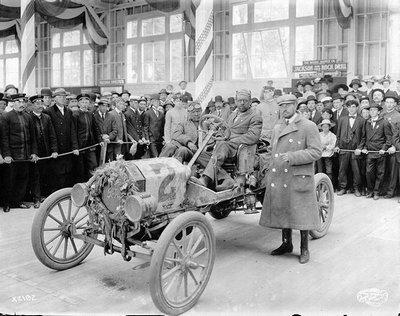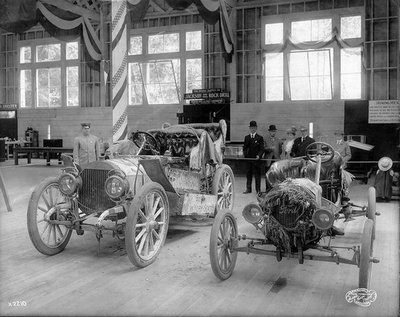July 9, 2009
A century after the AYPE’s cross-country race, old Model Ts are on the road again
On June 23, 1909, the first automobile of six entrants crossed the finish line on the UW campus after an “ocean to ocean endurance contest.” The event served to publicize the Alaska-Yukon-Pacific Exposition taking place on the UW campus, as well as the automobile industry, which was then in its infancy.
Now, 54 Model T Fords are wending their way toward Seattle, following the route of that race, and are scheduled to arrive on campus Sunday, July 12.
The drivers of 100 years ago arrived at the finish line after a long and grueling 23-day race. After all, there weren’t any interstate highways in 1909. Perhaps their greatest challenge came near the end, when they crossed Snoqualmie Pass. In an article on HistoryLink.org, Greg Lange calls the route over the pass “little more than a wagon road.” He quotes from an account by two of the race participants:
“We were on the top of the last difficulty. We had pushed through the snow with less trouble than we had expected. We would be in Seattle by four o’clock. When a rock hidden in the mud and snow sprang up to give us one last foul blow. For seven hours we worked on the top of the mountain up among the clouds remedying the trouble that rock had caused. At 5 p.m. [June 23] we were going again. A half mile over the ties of the new ‘Milwaukee’ railroad brought us to the down grade and ninety miles from the finish. The rest was easy”
The centennial re-enactment of the race (which is not actually a race but a drive following the same route) came about because of the enthusiasm of members of the Model T Club of America, especially Peter and Mary Bernhardt, who live in Virginia and own six Model Ts.
“I fell in love with old cars when I was a kid and saw the movie Genevieve,” Peter Bernhardt said. “It was about a race of vintage cars. I begged my father to buy me one.”
After earning money to help pay for it, he got his first Model T at age 9, and was driving it on his own property long before he was old enough to drive on the road. His obsession has continued through his adult years, and now that he’s retired, he and his wife have more time to devote to the hobby. They started planning for the race re-enactment in 2004, coming to the UW in 2005 to do research.
By 2007, they were contacting the University’s Use of Facilities Committee to see if they could get permission to bring cars on campus at the end of the cross-country event. Chris Collins, a member of the Model T Club of Seattle and grandson of one of AYPE’s organizers, learned of the plans and brought them to the attention of the city, and the event gained support from the Office of Arts and Cultural Affairs in Seattle and 4Culture, King County’s cultural services agency.
It’s appropriate that the Model T Club should take the lead, because Henry Ford used the original race to promote his car and turn it into an icon. “Ford made a few Model T cars in 1908, and 16,000 in 1909,” said Michael Herschensohn, AYP general manager for the Office of Arts and Cultural Affairs. “The production doubled every year after that.”
A Model T was at first declared the winner of the race, and Ford touted the win in a PR blitz that made it a household name, Herschensohn said. The Model T was later disqualified because it was discovered that parts had been changed during the race, but that didn’t happen until the following November. By that time the maker of the final winner, called a Shawmut, was nearly out of business. (For the full story, see http://www.boston.com/news/local/massachusetts/articles/2009/06/14/model_t_enthusiasts_mark_race_centennial/)
Driving a Model T across the country is no picnic even today. Those old cars don’t have air conditioning and stereos (They’re so noisy you couldn’t hear a radio if you had one, Bernhardt said), and their mechanical systems are more fragile than those of modern cars. In fact, the participants in the re-enactment have set aside every fourth day for maintenance and are taking almost a week longer to make the trip than participants in the original race. You can follow the exploits of the drivers on their blogs at http://oceantoocean.ning.com/profiles/blog/list.
And you can welcome them when they arrive. They’ll enter campus via Memorial Way between 10 and 11 a.m., turn onto Stevens Way, then onto Grant Lane and up to Frosh Pond to the strains of the Sedentary Sousa Band. There they’ll be greeted by Mayor Greg Nickels and UW President Mark Emmert, who will both speak. The cars will depart around noon for downtown Seattle, where they will drive down Fifth Avenue.
The Model Ts aren’t the only attraction of the day. To juxtapose cars of the past with those of the future, the Seattle Electric Vehicle Association will have a display of anywhere from six to 10 cars on Red Square beginning at 9:30 a.m. Some members of the association in their electric vehicles, along the City of Seattle’s electric plug-in hybrid vehicle, will also be leading the Model Ts from Renton to Seattle, said Association President Steven Lough.
The University will get involved by displaying two of its electric vehicles — a Prius hybrid plug-in and a Miles electric pickup truck, according to Larissa Austin of Fleet Services. Representatives of Fleet Services and the association will be on hand to talk to visitors about the vehicles.
For association members, this is just one more chance to promote electric cars, Lough said. The group has been around since 1967, with a three-pronged mission: educate, demonstrate and proliferate. “We’re convinced this is the car of the future,” he said.
Bernhardt, however, loves the cars of the past. “I love the era the cars represent,” he said. “It was a time when Americans did everything and were very self reliant.”
The events on July 12 are free and open to the public.




